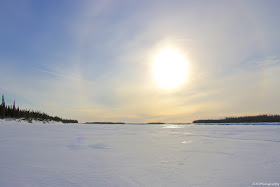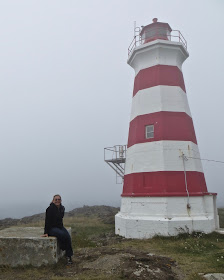Extending hospitality was a cardinal rule
in remote communities of the North a half century ago,
and tiny Lansdowne House was no exception.
It is amazing how much socializing and entertaining
went on among its twenty-two white people
(fourteen adults and eight children).
A Social Evening at the Roman Catholic Mission
Father Ouimet, Don MacBeath, Brother Bernier, and Mr. Baker (a Prospector)
Lansdowne House, Northern Ontario, Fall 1960
© M. Louise (MacBeath) Barbour/Fundy Blue
All Rights Reserved
I say white people, because at that time
whites and Ojibway didn't mix socially,
except at special events, during church,
or at the movies at the Roman Catholic Mission.
My father had a good relationship with the Ojibway in the community,
but the reality was that the Ojibway rarely visited white homes,
and white adults rarely visited Ojibway homes unless on official business.
My father, who worked for the Department of Indian Affairs,
was operating under prohibitions which he articulated
in his handbook The Northern School Teacher.
Two regulations that northern teachers strictly adhered to were
"No fraternizing with Indians of Opposite Sex"
and "No drinking with Indians on or off school property."
Bill Mitchell Talks with an Ojibway Man
Hudson's Bay Store, Lansdowne House
Photo by Donald MacBeath, Fall 1960
© M. Louise (MacBeath) Barbour/Fundy Blue
All Rights Reserved
As a girl of ten, my interactions with Ojibway children took place primarily at school,
although we frequently played with the Kitchejohn girls outside our home.
As for my best friends Simon and George,
they were six or seven years older than I,
and it would have been inappropriate for us
in both cultures to associate outside of school.
Furthermore, as older teenagers,
the two boys had increasing responsibilities at home.
The Ojibway treated my family with courtesy and kindness.
The adults quickly realized our family was unaware of
some of the inherent dangers in the bush,
and they kept a sharp eye on us when we were outside playing.
If Baby Bertie so much as stumbled or sat down playing outside,
any nearby Ojibway adult came running,
usually with a stick of wood or other weapon,
for fear of a dog attacking her.
Stories of Indian dogs mauling or killing white children
circulated around the north, and even I had heard them.
Sled Dog ~ Not All Were Tied On
Most days in Lansdowne House were routine ones,
and life for us quickly settled into a pleasant rhythm,
with the white adults socializing among themselves
and entertaining visitors from the Outside.
On Thursday, March 9, 1961 my mother wrote
to her mother-in-law, Myrtle MacBeath:
Dear Mother:-
Another week has flown by.
Mr. Pratt, Assistant Manager
for Indian Affairs,
was down to Lansdowne
for nearly a week
and came in for a couple
of evenings to visit us.
Sally (MacDonald) MacBeath
Acadia University, 1947
© M. Louise (MacBeath) Barbour/Fundy Blue
All Rights Reserved
The first time was to show us the plans
for our new house they are building
and to ask for any suggestions for color schemes.
They meant to get them from me when I arrived in Nakina,
but decided I would be too tired.
They suggested colors that were used in the last house they built,
so we said we wouldn’t make any changes.
The plans look very nice, and it will be modern with electricity,
running water, bathroom complete with plumbing, etc.
We played bridge with Uno and Mr. Pratt Tuesday night,
and Uno and I beat them. The score was very close.
Wednesday night Don and I went
to the Mitchell’s for bridge.
We had a nice time.
Mrs. Mitchell is quite a talker.
She has been in the North since
she married when she was nineteen.
She is somewhere in her fifties,
I believe, and looks very young.
Mrs. Mitchell, Wife of Bill Mitchell
© M. Louise (MacBeath) Barbour/Fundy Blue
All Rights Reserved
Her husband came from Aberdeen Scotland
about thirty-five years ago,
and he had lived in the North all that time.
They have a very nice home.
They have three children,
a boy and girl in their twenties and a boy twelve.
Mr. Mitchell and I beat Don and Mrs. Mitchell.
The score was very close again though.
Don had to go to Nakina overnight on school business.
When they took off they flew low over the house to bid us good-bye.
Mike came in to light the lamps for me,
and if Don is detained by weather tomorrow,
the men will get together and bring us over water.
A Modern DeHavilland DC-6 "Twin Otter"
The North Relied on Bush Pilots and Their Bush Planes
I am teaching school tomorrow morning,
perhaps in the afternoon too.
Maureen is looking after Roberta for me.
It will be quite an experience,
for I imagine the Indian children won’t talk to me.
All the Indians here are very friendly.
Don was unable to write for he didn’t know until this morning
that he would be leaving for Nakina.
I assured him that I would write and tell you the news.
The children are all fine and happy.
Don bought them a toboggan,
and it is hard to get them in the house
they love it outside so much.
They are building a toboggan run below the house.
I must close now and get off the mail and finish up the supply list.
I find it difficult to figure out exactly what we need,
but after a month of it I imagine it will come automatically.
I make all our bread except for the odd loaf.
I hope you and Aunt Maude are well.
Louise had letters started, but didn’t finish them.
We had to have everything in order
so we could get an early start tomorrow morning.
With love,
Sara.
Donnie and I, Still Tobogganing
Photo by a niece or nephew, Christmas Eve, 2016
© M. Louise (MacBeath) Barbour/Fundy Blue
All Rights Reserved
My mother's newsy letter looks ordinary on the surface,
but it points to some real differences from life on the Outside.
Hospitality is one of them.
My father wrote of this in his handbook:
"When you are in the north be hospitable to all transient guests
such as pilots, missionaries, Indian Affairs Branch officials,
Royal Canadian Mounted Police, Ontario Provincial Police, and others.
"Always offer coffee or tea and invite them for a meal.
If guests of this nature have to stay overnight
always offer them a place to sleep.
"All travelers in the north carry sleeping bags and air mattresses,
and a chesterfield or even a smooth floor in a warm room will suffice.
"The need for hospitality can not be over emphasized.
Travel in the north depends upon mutual hospitality,
and from a practical point of view,
you never know when you may be forced
to accept the hospitality of someone else."
Have Bed, Will Travel
During early 1961 we had a number of pilots and priests
bunking on the chesterfield in our living room.
I'm guessing that Mr. Pratt spent his week staying at the mission
or with Dad's former roommate Uno.
Guaranteed Mr. Pratt made the rounds to visit
all the white people in Lansdowne House
for coffee or tea, a meal, or an evening of bridge.
The only place outside of northern Ontario
that my family experienced the level
of hospitality we enjoyed in Lansdowne House
was in the outports of Newfoundland.
There too, people lived on the edge
with unreliable access to larger communities and services.
The most generous and compassionate people I have met
are among those who had the least.
When your very life might depend on another's hospitality,
you were hospitable under any circumstance.
I'll get to some other differences between the north and the Outside in my next post.
An Evening of Cards
Uno and Brian
Photo by Donald MacBeath, Winter 1960
© M. Louise (MacBeath) Barbour/Fundy Blue
All Rights Reserved
Till next time ~
Fundy Blue.
Notes:
1. Our New House:
The teacherage in Lansdowne House had burned down before my father arrived in the community.
That is why he had to room with Uno and why we couldn't join him, until he got permission to use
the Forestry building.
2. Sleeping Bags:
Fifty years ago sleeping bags were not the mummy-shaped marvels of lightweight fabric,
waterproof synthetic down, and advanced construction available today. In Lansdowne House our
family slept in sleeping bags rated for Arctic weather down to -30 ºF or -34ºC, similar to the
Woods Arctic Eiderdown Sleeping Robe pictured above. The sleeping bags were toasty warm,
and they had an outside flap sewn to the top of the bag that we could pull over our heads and
shoulders. Our house had a stove fueled by oil which my father kept turned low at night.
3. A Personal Note:
I am on the road again which is why this post is late today. I may not have access to internet for
the next day or two. I will respond to comments and visit your posts as soon as I can.
For Map Lovers Like Me:
Map of Canada
Highlighting Ontario
Location of Lansdowne House
Lansdowne House
Sketch by M. Louise Barbour
© M. Louise (MacBeath) Barbour/Fundy Blue
All Rights Reserved
Peninsula and Island
Lansdowne House, Northern Ontario
Credit: Canada. Dept. of Indian Affairs and Northern Development
Library and Archives Canada: PA-094992
Rough Sketch of Lansdowne House
by Donald MacBeath, Fall 1960
© M. Louise (MacBeath) Barbour/Fundy Blue
All Rights Reserved
This sketch shows the Father's Island and the tip of the "Mainland" peninsula
that contained the community of Lansdowne House.
2 ~ Dad's and Uno's Shack
12 ~ Hudson Bay Store
14 ~ Mitchells' House
18 ~ MacRaes' House
22 ~ Site for the New Teacherage
between Dad's School and the Nursing Station
29 ~ Usual Path of My Canoe

























